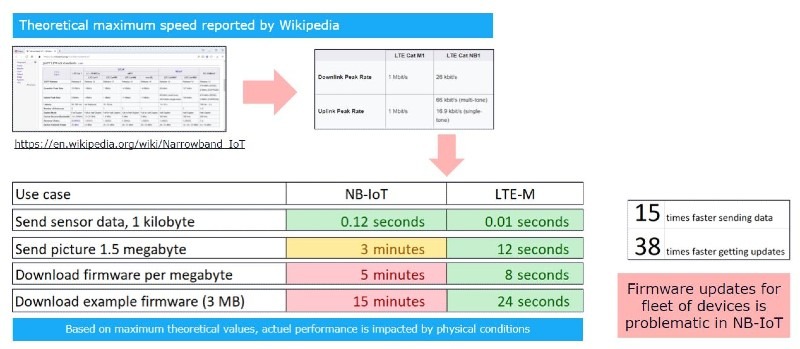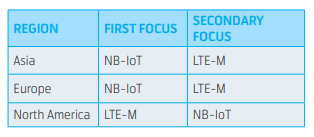What Is LTE-M?
LTE-M (also LTE-MTC and LTE Cat M) is a Low Power Wide Area Network (LPWAN) technology which allows the reuse of an LTE installed base with extended coverage. LTE-M, which stands for LTE-Machine Type Communication (MTC), is also a LPWAN technology developed by 3GPP to enable devices and services specifically for IoT applications. LTE-M offers a data rate of 1Mbps for 3GPP Release 13, rising to 4Mbps for Release 14, greater mobility and voice capability over the network.
What Is NB-IoT (Narrowband IoT)?
NB-IoT (Narrowband IoT) is a radio technology deployed over mobile networks which is especially suited for indoor coverage, low cost, long battery life, and large number of devices. NB-IoT limits bandwidth to a single narrow band of 200kHz, offering peak downlink speeds of 26kbs in Release 13 of the 3GPP standard. Release 14 will see this increase to 127kbps.
Guide to Mobile IoT: How to Choose between LTE-M and NB-IoT for Global Deployments
This white paper will serve as a guide to making informed decisions about LTE-M and NB-IoT technologies. You will be able to examine the potential benefits and explore the challenges involved in adopting this technology.
Introduction to the new network technologies LTE-M and NB-IoT
Two new network technologies, both based on mobile (cellular) technology, are entering the market in the form of LTE-M and NB-IoT – both created to be particularly suitable for enabling global IoT connectivity.
LTE-M and NB-IoT are both good connectivity options for industries looking to take advantage of LPWAN (Low Power Wide Area Networks) technology, that enhances the battery life of devices and connects devices that have previously been hard to reach. They are both available today, standardized and built on the 4G network which means they are future-proof, have global network coverage and are backed up by GSMA and telecom standards.
Connectivity is a crucial part of product design and performance and the choice of connectivity technology must be considered early in the process. This is a challenging choice given the quick technology and market development. 5G technologies are around the corner, 2G and 3G networks are starting to be phased out and new network technologies that support LPWAN are starting to become globally available in the form of LTE-M and NB-IoT – also referred to as Mobile IoT.
For the first time networks have been developed to answer to the specific needs of connecting things. Previously, connected units have been communicating on infrastructure developed for consumer needs.
LTE-M and NB-IoT are standardized, secure, and operator-managed in licensed spectrum. They are designed for IoT applications that are low cost, use low data rates, require long battery lives and often operate in locations that are hard to reach.
LTE-M and NB-IoT will be the obvious choices for industries looking for 2G and 3G replacements for devices with long lifecycles, requiring extended device battery life and coverage.
Both technologies are good choices for deployments with expected lifespans of a decade or more, however there are differences between them which make each of them more suitable for some IoT applications rather than others.
So, which one is the best choice for your application?
This guide describes the relative benefits and limitations of each technology to help enterprises to make the right selection for long-term success.
Definitions of industry terms and abbreviations can be found at the end of the white paper. Find more information on our managed connectivity offering.
Advantages of LTE-M and NB-IoT technologies
LTE-M and NB-IoT are designed to support IoT devices that need a long battery life or are used at locations that are difficult to reach with normal 4G technology, such as deep indoor locations. So how are they different and how will they affect the market?

Battery life and increased coverage
Battery life is increased by reducing the radio communication between device and network, and devices can go into sleep mode or listen less often to the network. LTE-M and NB-IoT both offer better coverage than 4G in, for example, deep indoor or remote areas. There is however a trade-off between battery life, coverage and responsiveness. To leverage this requires access to new types of functionality in the network- for example PSM and eDRX.
Use cases that need a fast response are less suitable for battery saving and enhanced coverage. Likewise, devices that need a life cycle of 10 years need to be deployed in areas with good coverage. To support a balanced approach, battery saving, and enhanced coverage are applied in step with each other. Significant improvement in battery life and coverage can be achieved by sleep mode and applying the right level of repetitions.
New pricing models likely to emerge
Pricing models for LTE-M and NB-IoT will likely be different to traditional telecom pricing because of the different traffic profile involved with IoT connectivity. There will be a vast number of connected LTE-M and NB-IoT devices, but they will send low amounts of data. Rather than the data consumption per device price model, network providers will most likely consider charging access fees for devices on a per device basis for LTE-M and NB-IoT, or a combination of both, to better match the network resources consumed by these devices.
Hardware simplification
LTE-M and NB-IoT both use simplified versions of regular 4G which reduces hardware complexity and cost once the technology is operating at scale.
GSMA maintains a list of modules that are commercially available, showing that the market for modules is fragmented into three main categories: modules supporting either LTE-M or NB-IoT and modules that support both LTE-M and NB-IoT.
Key differences between LTE-M and NB-IoT

- LTE-M is the better alternative with respect to handling firmware and software updates that are expected during the lifecycle of the devices. LTE-M is built for roaming and has the best support for international deployments using a single point of contact and subscription for enterprises.
- Both LTE-M and NB-IoT have significantly improved indoor coverage compared with LTE.
- LTE-M is a better alternative for moving devices as it will not lose ongoing data transfers.
- LTE-M is prepared for voice technology and Voice over LTE.
- With LTE-M, devices can react in milliseconds if required, enabling use cases where a fast response is needed which is relevant for the usability of human-machine interactions.

Theoretical maximum speed for LTE-M and NB-IoT reported by Wikipedia. The figues are based on maximum theoretical values, the actual performance is impacted by physical conditions.
Watch our recorded webinar “LTE-M vs NB-IoT”
Webinar: LTE-M vs NB IoT, an urgent matter for global companies
LTE-M and NB-IoT – Global availability and outlook
Moving towards local availability in all countries
For global deployments of devices, enterprises need to take the life cycle of technology in consideration.
Global deployments need global availability, but new technologies are first locally available, typically in urban areas or with nationwide deployments. So, when can we expect global availability for LTE-M and NB-IoT?
Today, the status for LTE-M and NB-IoT is that they are both locally available and, on their way, to becoming globally available.
We see that sometimes one operator in a region starts focusing on either LTE-M or NB-IoT, after which their competitors in the same region often offers the alternative.
We expect that in a few years both LTE-M and NB-IoT will be locally available in all countries.

Nationwide deployments are a good start but for global availability, commercial global roaming agreements between operators must be in place, so enterprises can deploy their devices using only one contract and one point of contact.
With 4G widely available and 5G around the corner, 2G and 3G are slowly being phased out. 2G technology is today still widely used in IoT solutions. 2G voice technology is used for voice calling, including emergency calls such as eCall – a European initiative for rapid assistance to motorists involved in a collision anywhere in the European Union. eCall was made mandatory in all new type-approved cars sold in the European Union from April 2018. As eCall mandates 2G voice, operators in the European Union cannot simply phase out 2G.
We expect that most European operators will support 2G until 2025. In North America, 2G is less widely available and certain countries in Asia and the Pacific have already phased out 2G.
LTE-M and NB-IoT are starting to become globally available, starting with LTE-M. We expect LTE-M and NB-IoT to be available during the complete lifecycle of 5G.
Please continue reading in the PDF. Topics covered in the white paper:
- What is LTE-M and NB-IoT?
- What is the best choice for your low-power IoT application?
- What is the relative merits and limitations of each technology to help you make the right selection for long term success
- Global availability and outlook
- How should international companies think and act in the transition between 2G/3G to the new technologies for connected things?

